The Role of Mineral Assemblages in The Environmental Impact of Cu-Sulfide Deposits: A Case Study from Norway
Abstract
1. Introduction
2. Geological Settings
2.1. Sediment-Hosted Cu Deposits of Nussir and Ulveryggen, Repparfjord Tectonic Window
2.2. Volcanogenic Massive Sulfide (VMS) Deposit Røros, the Upper Allochthon of Scandinavian Caledonides
3. Materials and Methods
4. Results
4.1. Mineral Analyses
4.1.1. Nussir and Ulveryggen
4.1.2. Røros
4.2. Leaching Tests
4.3. Raman Spectroscopy
4.4. Mineral Chemistry
4.4.1. Nussir and Ulveryggen
4.4.2. Røros
5. Discussion
6. Conclusions
Supplementary Materials
Author Contributions
Funding
Data Availability Statement
Acknowledgments
Conflicts of Interest
References
- Gordon, R.B.; Bertram, M.; Graedel, T.E. Metal Stocks and Sustainability. Proc. Natl. Acad. Sci. USA 2006, 103, 1209–1214. [Google Scholar] [CrossRef]
- Schlesinger, M.E.; King, M.J.; Sole, K.C.; Davenport, W.G. Extractive Metallurgy of Copper, 5th ed.; Elsevier: Oxford, UK, 2011; p. 472. [Google Scholar]
- Elshkaki, A.; Graedel, T.E.; Ciacci, L.; Reck, B.K. Copper demand, supply, and associated energy use to 2050. Global Environ. Chang. 2016, 39, 305–315. [Google Scholar] [CrossRef]
- Ossandón, C.G.; Fréraut, C.R.; Gustafson, L.B.; Lindsay, D.D.; Zentilli, M. Geology of the Chuquicamata mine: A progress report. Econ. Geol. 2001, 96, 249–270. [Google Scholar] [CrossRef]
- Cannell, J.; Cooke, D.R.; Walshe, J.L.; Stein, H. Geology, mineralization, alteration, and structural evolution of the El Teniente porphyry Cu-Mo deposit. Econ. Geol. 2005, 100, 979–1003. [Google Scholar] [CrossRef]
- Large, S.J.; Quadt, A.V.; Wotzlaw, J.F.; Guillong, M.; Heinrich, C.A. Magma evolution leading to porphyry Au-Cu mineralization at the Ok Tedi deposit, Papua New Guinea: Trace element geochemistry and high-precision geochronology of igneous zircon. Econ. Geol. 2018, 113, 39–61. [Google Scholar] [CrossRef]
- Garside, M. Copper–Statistics & Facts. Available online: https://www.statista.com/topics/1409/copper/ (accessed on 7 June 2021).
- Flanagan, D.M. Mineral Commodity Summaries; U.S. Geological Survey: Reston, VA, USA, 2021. [Google Scholar]
- Garside, M. Major Countries in Copper Mine Production Worldwide from 2010 to 2020. Available online: https://www.statista.com/statistics/264626/copper-production-by-country/ (accessed on 7 June 2021).
- Mudd, G.M.; Jowitt, S.M. Growing global copper resources, reserves and production: Discovery is not the only control on supply. Econ. Geol. 2018, 113, 1235–1267. [Google Scholar] [CrossRef]
- Pietrzyk, S.; Tora, B. Trends in global copper mining—A review. Miner. Eng. Conf. 2018, 427, 012002. [Google Scholar] [CrossRef]
- Lepan, N. Everything You Need to Know about VMS Deposits. Vis. Capital. 2019. Available online: https://www.mining.com/web/everything-need-know-vms-deposits/ (accessed on 7 June 2021).
- Nussir ASA. Available online: www.nussir.no (accessed on 30 November 2020).
- Sandstad, J.S.; Bjerkgård, T.; Boyd, R.; Ihlen, P.; Korneliussen, A.; Nilsson, L.P.; Often, M.; Eilu, P.; Hallberg, A. Metallogenic areas in Norway. In Mineral Deposits and Metallogeny of Fennoscandia; Geological Survey of Finland: Espoo, Finland, 2012; Volume 53, pp. 35–138. [Google Scholar]
- Banks, D.; Younger, P.L.; Arnesen, R.T.; Iversen, E.R.; Banks, S.B. Mine-water chemistry: The good, the bad and the ugly. Environ. Geol. 1997, 32, 157–174. [Google Scholar] [CrossRef]
- Dudka, S.; Adriano, D.C. Environmental impacts of metal ore mining and processing: A review. J. Environ. Qual. 1997, 26, 590–602. [Google Scholar] [CrossRef]
- Bridge, G. The social regulation of resource access and environmental impact: Production, nature and contradiction in the US copper industry. Geoforum 2000, 31, 237–256. [Google Scholar] [CrossRef]
- Berrill, P.; Arvesen, A.; Scholz, Y.; Gils, H.C.; Hertwich, E.G. Environmental impacts of high penetration renewable energy scenarios for Europe. Environ. Res. Lett. 2016, 11, 014012. [Google Scholar] [CrossRef]
- Seal, R.R., II; Foley, N.K. (Eds.) Progress on Geoenvironmental Models for Selected Mineral Deposit Types; U.S. Geological Survey: Reston, VA, USA, 2002; pp. 2002–2195. [Google Scholar]
- Parbhakar-Fox, A.K.; Edraki, M.; Walters, S.; Bradshaw, D. Development of a textural index for the prediction of acid rock drainage. Miner. Eng. 2011, 24, 1277–1287. [Google Scholar] [CrossRef]
- Dold, B.; Weibel, L. Biogeometallurgical pre-mining characterization of ore deposits: An approach to increase sustainability in the mining process. Environ. Sci. Pollut. R. 2013, 20, 7777–7786. [Google Scholar] [CrossRef]
- Anawar, H.M. Sustainable rehabilitation of mining waste and acid mine drainage using geochemistry, mine type, mineralogy, texture, ore extraction and climate knowledge. J. Environ. Manag. 2015, 158, 111–121. [Google Scholar] [CrossRef]
- Bussière, B. Acid mine drainage from abandoned mine sites: Problematic and reclamation approaches. In Proceedings of the International Symposium on Geoenvironmental Engineering, ISGE 2009, Hangzhou, China, 8 September 2009; pp. 111–125. [Google Scholar]
- Simate, G.S.; Ndlovu, S. Acid mine drainage: Challenges and opportunities. J. Environ. Chem. Eng. 2014, 2, 1785–1803. [Google Scholar] [CrossRef]
- Braungardt, C.B.; Achterberg, E.P.; Elbaz-Poulichet, F.; Morley, N.H. Metal geochemistry in a mine-polluted estuarine system in Spain. Appl. Geochem. 2003, 18, 1757–1771. [Google Scholar] [CrossRef]
- Enspaña, J.S.; López Pamo, E.; Esther, S.; Aduvire, O.; Reyes, J.; Barettino, D. Acid mine drainage in the Iberian Pyrite Belt (Odiel river watershed, Huelva, SW Spain): Geochemistry, mineralogy and environmental implications. Appl. Geochem. 2005, 20, 1320–1356. [Google Scholar]
- Akcil, A.; Koldas, S. Acid mine drainage (AMD): Causes, treatment and case studies. J. Clean. Prod. 2006, 14, 1139–1145. [Google Scholar] [CrossRef]
- Ayora, C.; Caraballo, M.A.; Macias, F.; Rötting, T.S.; Carrera, J.; Nieto, J.-M. Acid mine drainage in the Iberian Pyrite Belt: 2. Lessons learned from recent passive remediation experiences. Environ. Sci. Pollut. Res. 2013, 20, 7837–7853. [Google Scholar] [CrossRef] [PubMed]
- Kefeni, K.K.; Msagati, T.A.M.; Mamba, B.B. Acid mine drainage: Prevention, treatment options, and resource recovery: A review. J. Clean. Prod. 2007, 151, 475–493. [Google Scholar] [CrossRef]
- Dold, B. Submarine tailings disposal (STD)—A review. Minerals 2014, 4, 642–666. [Google Scholar] [CrossRef]
- Tabelin, C.B.; Igarashi, T.; Villacorte-Tabelin, M.; Park, I.; Einstin, M.O.; Ito, M.; Hiroyoshi, N. Arsenic, selenium, boron, lead, cadmium, copper, and zink in naturally contaminated rocks: A review of their sources, modes of enrichment, mechanisms of release, and mitigation strategies. Sci. Total Environ. 2018, 645, 1522–1553. [Google Scholar] [CrossRef]
- Lottermoser, B. Mine Wastes Characterization, Treatment and Environmental Impacts, 3rd ed.; Springer: Berlin/Heidelberg, Germany, 2010; p. 400. [Google Scholar]
- De Andrade Lima, L.R.P. A mathematical model for isothermal heap and column leaching. Braz. J. Chem. Eng. 2004, 21, 435–447. [Google Scholar] [CrossRef]
- Gottschalk, V.H.; Buehler, H.A. Oxidation of sulphides. Econ. Geol. 1912, 7, 15–34. [Google Scholar] [CrossRef]
- Cheng, C.Y.; Lawson, F. The kinetics of leaching covellite in acidic oxygenated sulphate-chloride solutions. Hydrometallurgy 1991, 27, 269–284. [Google Scholar] [CrossRef]
- Falk, H.; Lavergren, U.; Bergbäck, B. Metal mobility in alum shale from Öland, Sweden. J. Geochem. Explor. 2006, 90, 157–165. [Google Scholar] [CrossRef]
- Rzepka, P.; Walder, I.F.; Aagaard, P.; Bożęcki, P.; Rzepa, G. Sub-sea tailings deposition leach modelling. Geol. Geophys. Environ. 2014, 40, 123–124. [Google Scholar]
- Tabelin, C.B.; Veerawattananun, S.; Ito, M.; Hiroyoshi, N.; Igarashi, T. Pyrite oxidation in the presence of hematite and alumina: I. Batch leaching experiments and kinetic modeling calculations. Sci. Total Environ. 2017, 580, 687–698. [Google Scholar] [CrossRef] [PubMed]
- Embile, R.F., Jr.; Walder, I.F. Galena non-oxidative dissolution kinetics in seawater. Aquat. Geochem. 2018, 24, 107–119. [Google Scholar] [CrossRef]
- Embile, R.F., Jr.; Walder, I.F.; Schuh, C.; Donatelli, J.L. Cu, Pb and Fe release from sulphide-containing tailings in seawater: Results from laboratory simulation of submarine tailings disposal. Mar. Pollut. Bull. 2018, 137, 582–592. [Google Scholar] [CrossRef] [PubMed]
- Huyen, D.T.; Tabelin, C.B.; Thuan, H.M.; Dang, H.D.; Truong, P.T.; Vongphuthone, B.; Kobayashi, M.; Igarashi, T. The solid-phase partitioning of arsenic in unconsolidated sediments of the Mekong Delta, Vietnam and its release under various conditions. Chemosphere 2019, 233, 512–523. [Google Scholar] [CrossRef]
- Tomiyama, S.; Igarashi, T.; Tabelin, C.B.; Tangviroon, P. Acid mine drainage sources and hydrogeochemistry at the Yatani mine, Yamagata, Japan: A geochemical and isotopic study. J. Contam. Hydrol. 2019, 225, 103502. [Google Scholar] [CrossRef]
- Silva, L.F.O.; Querol, X.; da Boit, K.M.; Fdez-Ortiz de Vallejuelo, S.; Madariaga, J.M. Brazilian coal mining residues and sulphide oxidation by Fenton’s reaction: An accelerated weathering procedure to evaluate possible environmental impact. J. Hazard. Mater. 2011, 186, 516–525. [Google Scholar] [CrossRef] [PubMed]
- Jambor, J.L.; Dutrizac, J.E.; Groat, L.A.; Raudsepp, M. Static tests of neutralization potentials of silicate and aluminosilicate minerals. Environ. Geol. 2002, 43, 1–17. [Google Scholar]
- Ruan, R.; Zhou, E.; Xingyu, L.; Biao, W.; Guiying, Z.; Jiankang, W. Comparison on the leaching kinetics of chalcocite and pyrite with or without barteria. Rare Metals. 2010, 29, 552–556. [Google Scholar] [CrossRef]
- Plante, B.; Bussière, B.; Benzaazoua, M. Static tests response on 5 Canadian hard rock mine tailings with low net acid-generating potentials. J. Geochem. Explor. 2012, 114, 57–69. [Google Scholar] [CrossRef]
- Banwart, S.A.; Destouni, G.; Malmström, M. Assessing mine water pollution: From laboratory to field scale. In Ground Water Quality: Remediation and Protection, Proceeding of the GQ’98 Conference; Tübingen, Germany, 21–25 September 1998, IAHS Publications: Wallingford, UK, 1998; Volume 250, pp. 307–311. [Google Scholar]
- Pharaoh, T.C.; MacIntyre, R.M.; Ramsay, D.M. K–Ar age determination on the Raipas suite in the Komagfjord Window, northern Norway. Nor. Geol. Tidsskr. 1982, 62, 51–57. [Google Scholar]
- Torgersen, E.; Viola, G.; Sandstad, J.S. Revised structure and stratigraphy of the northwestern Repparfjord Tectonic Window, Northern Norway. Norw. J. Geol. 2015, 95, 397–421. [Google Scholar] [CrossRef]
- Perelló, J.; Clifford, J.A.; Creaser, R.A.; Valencia, V.A. An example of synorogenic sediment-hosted copper Mineralization: Geologic and geochronologic evidence from the Paleoproterozoic Nussir deposit, Finnmark, Arctic Norway. Econ. Geol. 2015, 110, 677–689. [Google Scholar] [CrossRef]
- Torgersen, E.; Viola, G.; Sandstad, J.S.; Stein, H.; Zwingmann, H.; Hannah, J. Effects of frictional–viscous oscillations and fluid flow events on the structural evolution and Re–Os pyrite–chalcopyrite systematics of Cu-rich carbonate veins in northern Norway. Tectonophysics 2015, 659, 70–90. [Google Scholar] [CrossRef]
- Torgersen, E.; Viola, G.; Sandstad, J.S.; Stein, H. Structural constraints on the formation of Cu-rich mesothermal vein deposits in the Repparfjord Tectonic Window, northern Norway. In Proceedings of the 12th SGA Biennial Meeting, Uppsala, Sweden, 12–15 August 2013. [Google Scholar]
- Mun, Y.; Strmić Palinkaš, S.; Forwick, M.; Junttila, J.; Pedersen, K.B.; Sternal, B.; Neufeld, K.; Tibljaš, D.; Kullerud, K. Stability of Cu-sulfides in submarine tailing disposals: A case study from Repparfjorden, northern Norway. Minerals 2020, 10, 169. [Google Scholar] [CrossRef]
- Stribrny, B. The conglomerate-hosted Repparfjord copper ore deposit, Finnmark, Norway. In Monograph Series on Mineral Deposits; Gebrüder Borntraeger: Berlin, Germany; Stuttgart, Germany, 1985; Volume 24, pp. 1–75. [Google Scholar]
- Mun, Y.; Strmić Palinkaš, S.; Kullerud, K.; Nilsen, K.S.; Neufeld, K.; Bekker, A. Evolution of metal-bearing fluids at the Nussir and Ulveryggen sediment-hosted Cu deposits, Repparfjord Tectonic Window, Northern Norway. Norw. J. Geol. 2020, 100. [Google Scholar] [CrossRef]
- Norwegian Geological Survey. Available online: www.ngu.no (accessed on 12 October 2020).
- Ettner, D. Passive mine water treatment in Norway. In Water in Mining Environments; Cidu, R., Frau, F., Eds.; IMWA Symposium: Cagliari, Italy, 2007. [Google Scholar]
- Rui, I.J.; Bakke, I. Stratabound sulphide mineralization in the Kjøli Area, Røros District, Norwegian Caledonides. Nor. Geol. Tidsskr. 1975, 55, 51–75. [Google Scholar]
- Bjerkgård, T.; Sandstad, J.S.; Sturt, B.A. Massive sulphide deposits in the south-eastern Trondheim region Caledonides, Norway: A review. In Mineral Deposits: Processes to Processing; Stanley, C.J., Ed.; Taylor & Francis: London, UK, 1999; pp. 935–938. [Google Scholar]
- Grenne, T.; Ihlen, P.M.; Vokes, F.M. Scandinavian Caledonide metallogeny in a plate tectonic perspective. Miner. Deposita 1999, 34, 422–471. [Google Scholar] [CrossRef]
- Gee, D.G.; Fossen, H.; Henriksen, N.; Higgins, A.K. From the early Paleozoic platforms of Baltica and Laurentia to the Caledonide Orogen of Scandinavia and Greenland. Episodes 2008, 31, 44–51. [Google Scholar] [CrossRef]
- Corfu, F.; Andersen, T.B.; Gasser, D. The Scandinavian Caledonides: Main features, conceptual advances and critical questions. Geol. Soc. Lond. Spec. Publ. 2014, 390, 9–43. [Google Scholar] [CrossRef]
- RRUF Project. Available online: https://rruff.info/ (accessed on 2 February 2021).
- Miljødirektoratet. Quality Standards for Water, Sediment and Biota; M-608; Norwegian Environment Agency (NEA): Oslo, Norway, 2016; p. 24. (In Norwegian) [Google Scholar]
- Barrie, C.T.; Hannington, M.D. Classification of volcanic-associated massive sulfide deposits based on host-rock composition. In Volcanic-Associated Massive Sulfide Deposits: Processes and Examples in Modern and Ancient Settings; Barrie, C.T., Ed.; Society of Economic Geologists: Littleton, CO, USA, 1999; pp. 1–11. [Google Scholar]
- Galley, A.G.; Hannington, M.D.; Jonasson, I.R. Volcanogenic massive sulphide deposits. In Mineral Deposits of Canada: A Synthesis of Major Deposit-Types, District Metallogeny, the Evolution of Geological Provinces, and Exploration Methods; Goodfellow, W.D., Ed.; Geological Association of Canada, Mineral Deposits Division, Special Publication: St. John’s, NL, Canada, 2007; Volume 5, pp. 141–161. [Google Scholar]
- Nordstrom, D.K.; Alpers, C.N. Geochemistry of acid mine waters. In The Environmental Geochemistry of Mineral Deposits, Part A. Processes, Techniques, and Health Issues; Plumlee, G.S., Longsdon, M.J., Eds.; Reviews in Economic Geology; Society of Economic Geologists: Littleton, CO, USA, 1999; Volume 6A, pp. 133–160. [Google Scholar]
- Hudson-Edwards, K.A.; Jamieson, H.E.; Lottermoser, B.G. Mine wastes: Past, present, future. Elements 2011, 7, 375–380. [Google Scholar] [CrossRef]
- Grimalt, J.O.; Ferrer, M.; Macpherson, E. The mine tailing accident in Aznacollar. Sci. Total Environ. 1999, 242, 3–11. [Google Scholar] [CrossRef]
- Levings, C.D.; Barry, K.L.; Grout, J.A.; Piercey, G.E.; Marsden, A.D.; Coombs, A.P.; Mossop, B. Effects of acid mine drainage on the estuarine food web, Britannia Beach, Howe Sound, British Columbia, Canada. Hydrobiologia 2004, 525, 185–202. [Google Scholar] [CrossRef]
- Parbhakar-Fox, A.K.; Lottermoser, B.; Bradshaw, D. Evaluating waste rock mineralogy and microtexture during kinetic testing for improved acid rock drainage prediction. Miner. Eng. 2013, 52, 111–124. [Google Scholar] [CrossRef]
- McKibben, M.A.; Tallant, B.A.; del Angel, J.K. Kinetics of inorganic arsenopyrite oxidation in acidic aqueous solutions. Appl. Geochem. 2008, 23, 121–135. [Google Scholar] [CrossRef]
- Temminghoff, E.J.M.; Van Der Zee, S.E.A.T.M.; De Haan, F.A.M. Copper mobility in a copper-contaminated sandy soil as affected by pH and solid and dissolved organic matter. Environ. Sci. Technol. 1997, 31, 1109–1115. [Google Scholar] [CrossRef]
- Balci, N.; Demirel, C. Prediction of acid mine drainage (AMD) and metal release sources at the Küre copper mine site, Kastamonu, NW Turkey. Mine Water Environ. 2017, 37, 56–74. [Google Scholar] [CrossRef]
- Pareuil, P.; Pénilla, S.; Ozkan, N.; Bordas, F.; Bollinger, J.-C. Influence of reducing conditions on metallic elements released from various contaminated soil samples. Environ. Sci. Technol. 2008, 42, 7615–7621. [Google Scholar] [CrossRef] [PubMed]
- Engineering ToolBox. Oxygen—Solubility in Fresh Water and Seawater. 2005. Available online: https://www.engineeringtoolbox.com/oxygen-solubility-water-d_841.html (accessed on 4 May 2021).
- Chizhikov, D.M.; Kovylina, V.N. Investigation of potentials and anodic polarization of the sulfides and their alloys. In Trudy Chetvertogo Soveshchaniya po Electrokhimii Akademii Nauk SSSR, Proceedings of the 4th Conference on Electrochemistry, Moscow, Russia, 1–6 October 1956; Frumkin, A.S., Ed.; Akademii Nauk SSSR: Moscow, Russia, 1956; pp. 715–719. [Google Scholar]
- Biegler, T.; Swift, D.A. Anodic behaviour of pyrite in acid solutions. Electrochem. Acta 1979, 24, 415–422. [Google Scholar] [CrossRef]
- Warren, G.W. The Electrochemical Oxidation of CuFeS2. Ph.D. Thesis, University of Utah, Salt Lake City, UT, USA, 1978. [Google Scholar]
- Ziemkiewicz, P.; Skousen, J.G. Open limestone channels for treating acid mine drainage: A new look at an old idea. Green Lands 1994, 24, 36–41. [Google Scholar]
- Selvarajan, P.; Chandra, G.; Bhattacharya, S.; Sil, S.; Vinu, A.; Umapathy, S. Potential of Raman spectroscopy towards understanding structures of carbon-based materials and perovskites. Emergent Mater. 2019, 2, 417–439. [Google Scholar] [CrossRef]

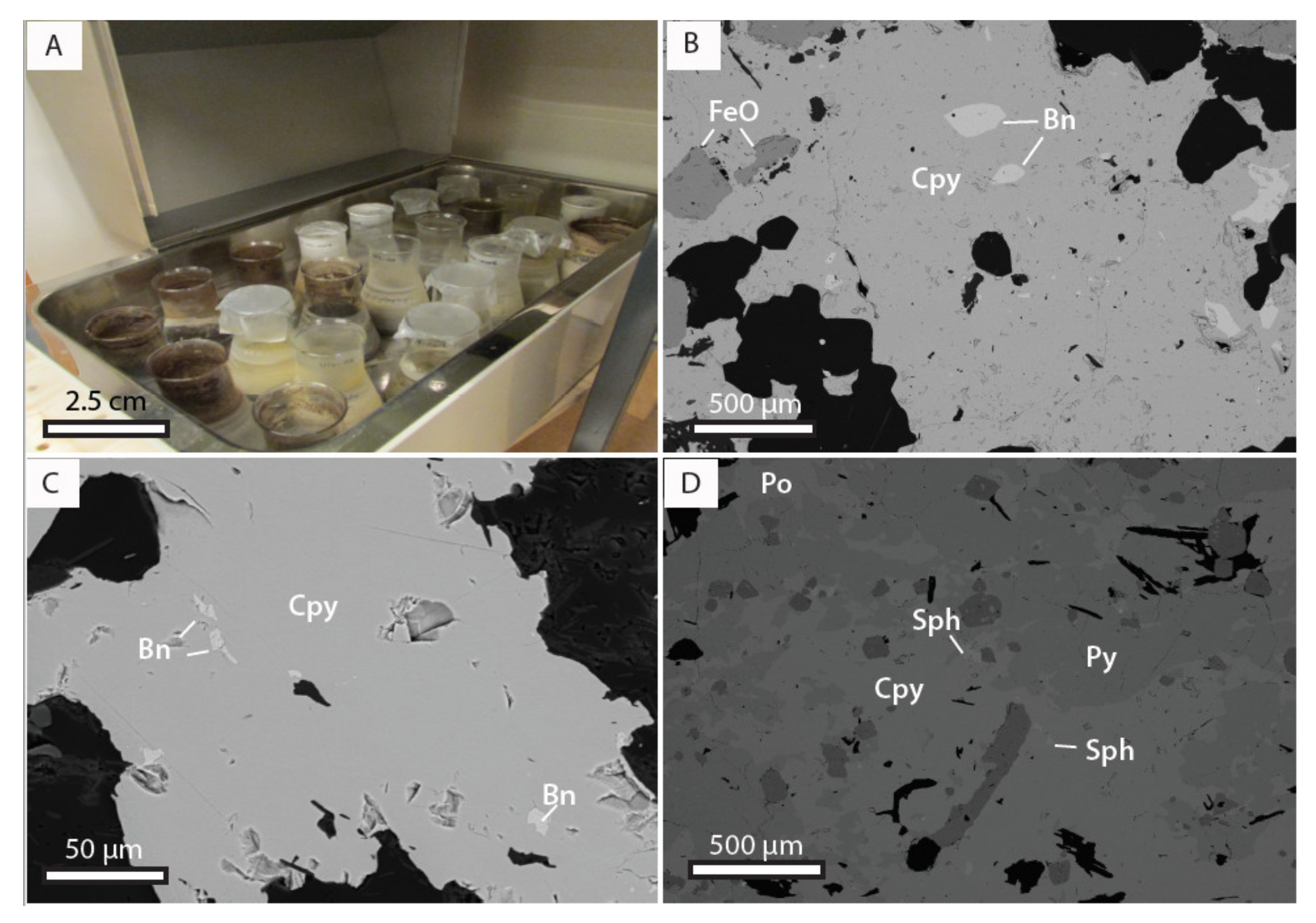
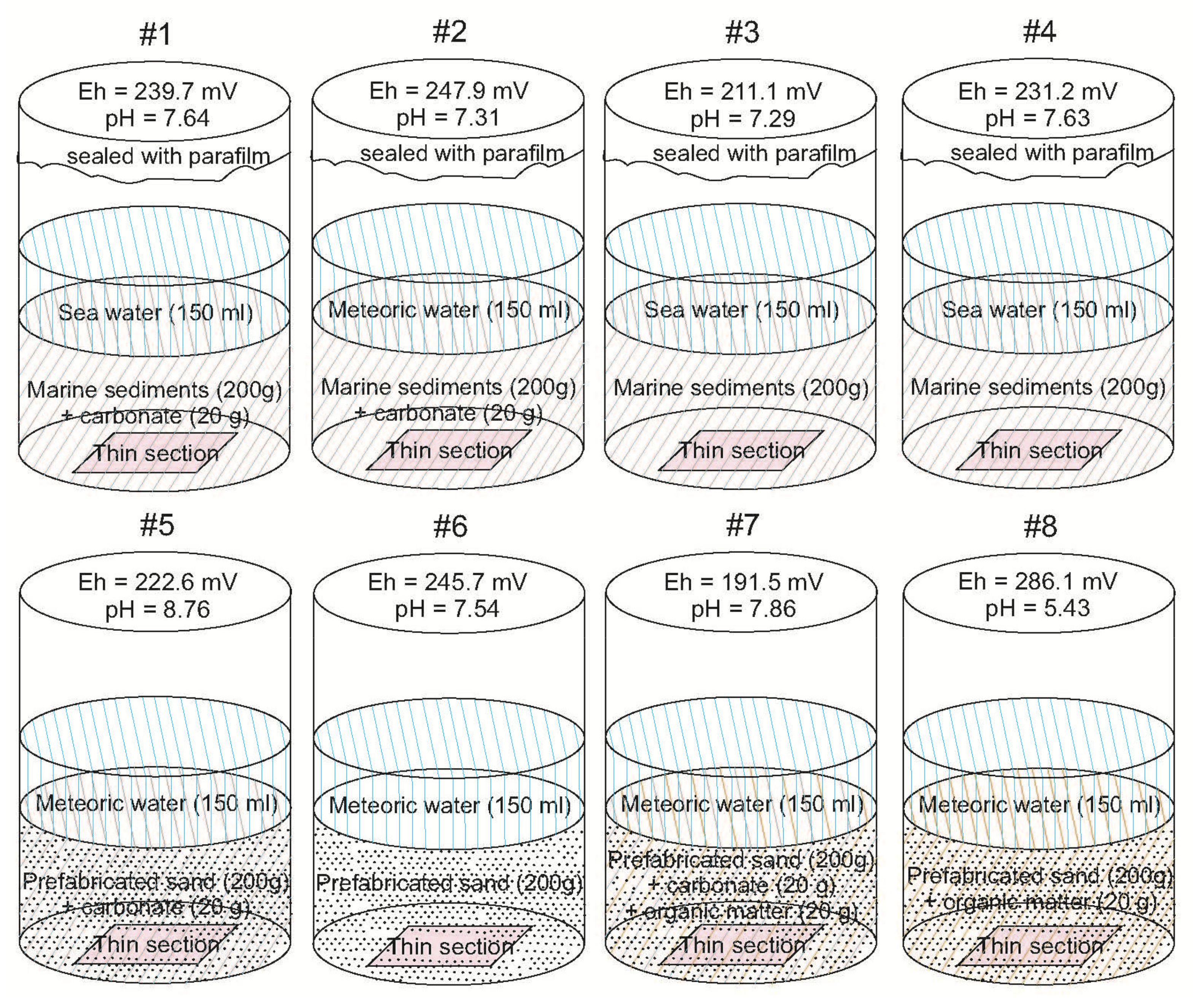
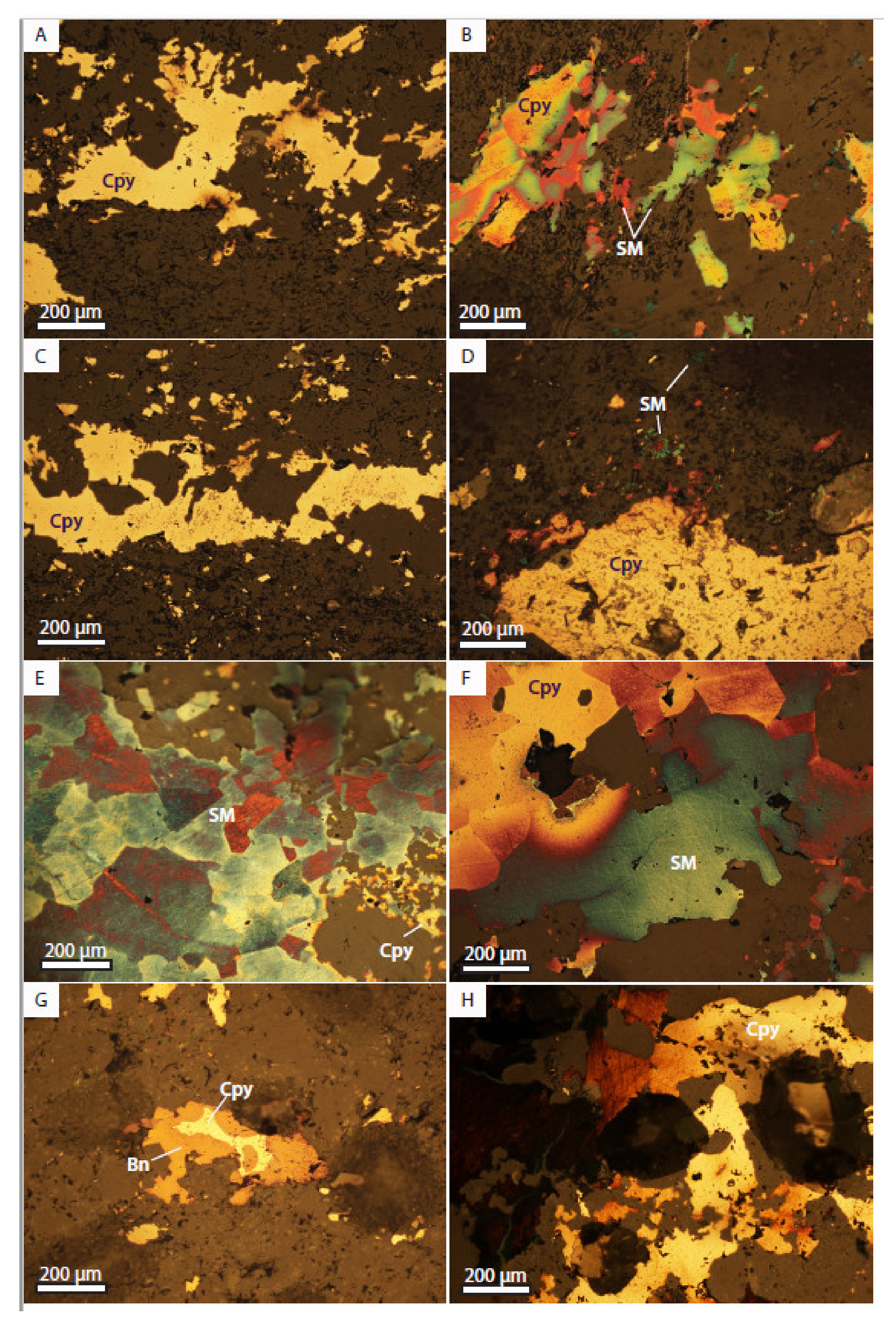
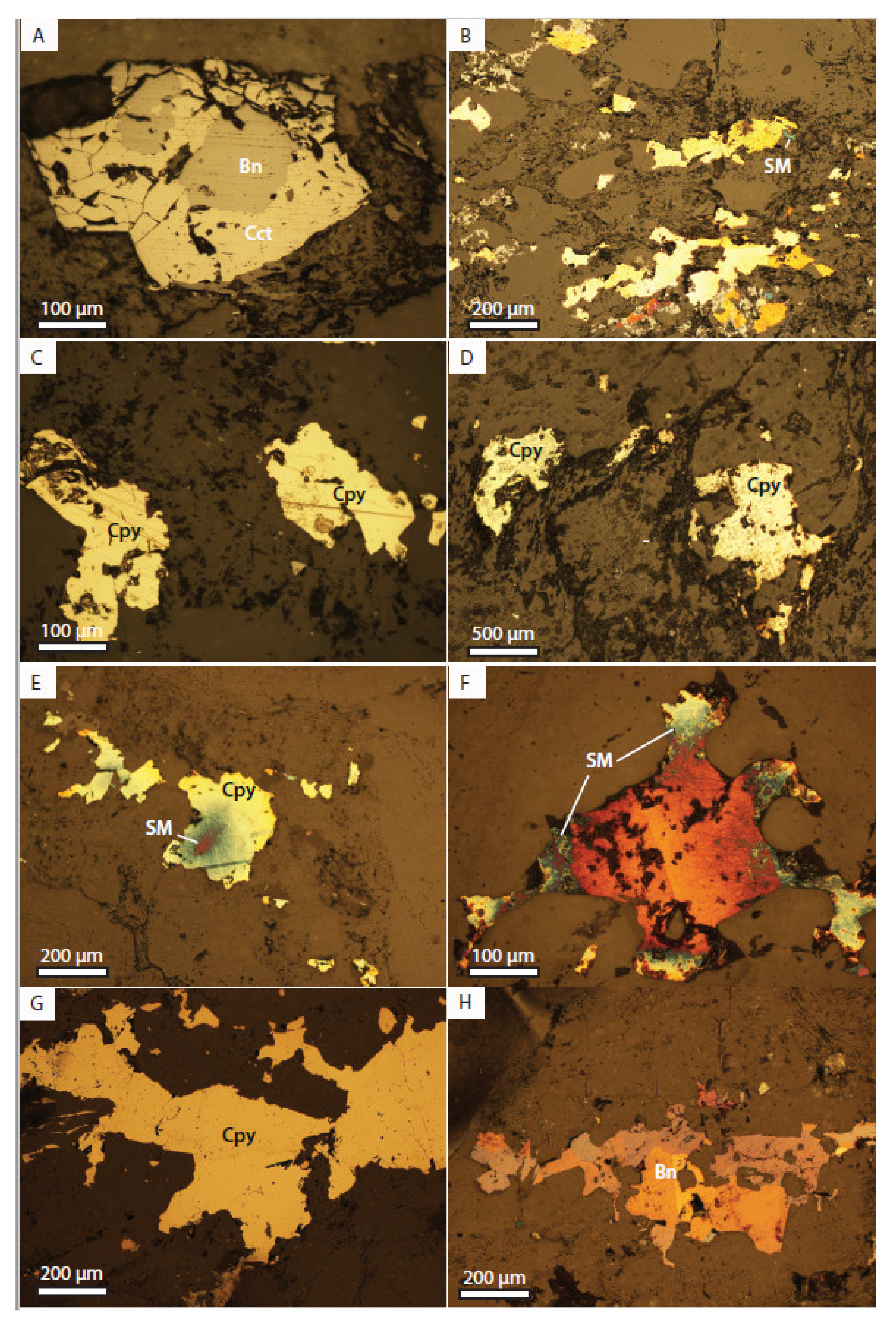

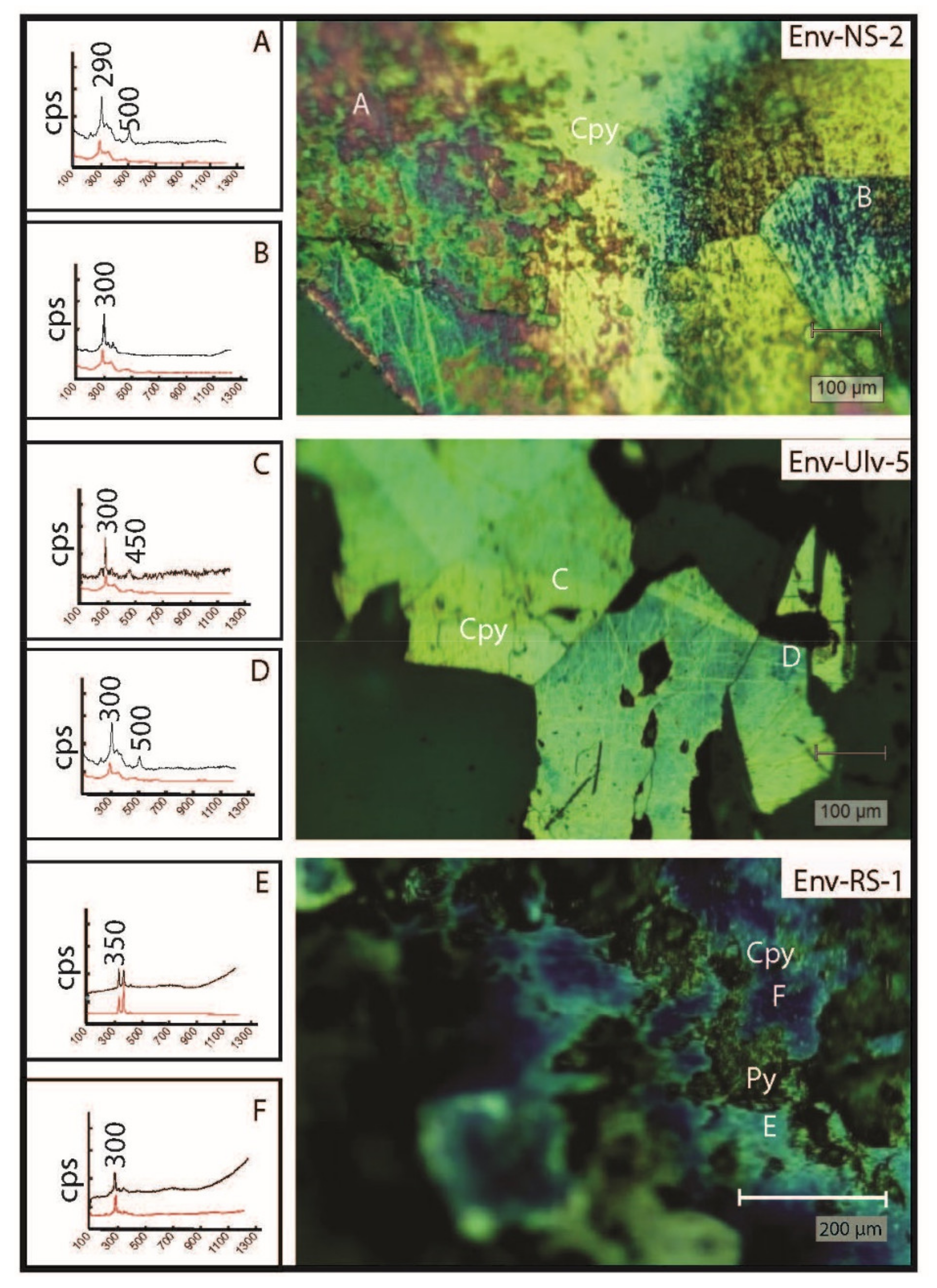
| Materials Used to Maintain the Designed Conditions | ||||||||
|---|---|---|---|---|---|---|---|---|
| Sample # | Condition # | Condition Description | Marine Sediment | Prefabricated Sand | Sea Water | Meteoric Water | Organic Matter | Carbonate |
| Env-1NS-1 Env-2Ulv-1 Env-3RS-1 | 1 | Marine sediments, TOC = 0.82 wt.%. Carbonate buffered Seawater | + + + | + + + | + + + | |||
| Env-NS-2 Env-Ulv-2 Env-RS-2 | 2 | Marine sediments, TOC = 0.82 wt.%. Carbonate buffered Meteoric water | + + + | + + + | + + + | |||
| Env-NS-3 Env-Ulv-3 Env-RS-3 | 3 | Marine sediments, TOC = 0.82 wt%, non-buffered. Seawater | + + + | + + + | ||||
| Env-NS-4 Env-Ulv-4 Env-RS-4 | 4 | Marine sediments, TOC = 0.82 wt.%, non-buffered. Meteoric water | + + + | + + + | ||||
| Env-NS-5 Env-Ulv-5 Env-RS-5 | 5 | Quartz sand, TOC=0 wt.%, carbonate-buffered. Meteoric water | + + + | + + + | + + + | |||
| Env-NS-6 Env-Ulv-6 Env-RS-6 | 6 | Quartz sand, TOC=0 wt.%, non-buffered. Meteoric water | + + + | + + + | ||||
| Env-NS-7 Env-Ulv-7 Env-RS-7 | 7 | Quartz sand, TOC=10 wt.%, carbonate-buffered. Meteoric water | + + + | + + + | + + + | + + + | ||
| Env-NS-8 Env-Ulv-8 Env-RS-8 | 8 | Quartz sand, TOC=10 wt.%, non-buffered. Meteoric water | + + + | + + + | + + + | |||
| Element, ppm | LD | 1 NS-35-ccp | 2 Ulv-2-bn | 3 RSL-ccp |
|---|---|---|---|---|
| As | 5 | LLD | LLD | 226.1 |
| Ba | 3 | 12 | 527 | 18 |
| Bi | 0.1 | 0.3 | 0.1 | 9.9 |
| Cd | 0.1 | LLD | LLD | 30 |
| Co | 1 | 85 | 2 | 535.9 |
| Cu | 10 | >10,000 | >10,000 | >10,000 |
| Hg | 0.01 | LLD | LLD | 4.59 |
| Mo | 2 | LLD | 5 | 6.5 |
| Ni | 0.1 | 100 | LLD | 7.8 |
| Pb | 5 | LLD | LLD | 196.1 |
| Rb | 1 | LLD | 24 | 2.5 |
| Sb | 0.2 | LLD | LLD | 1.8 |
| Sn | 1 | LLD | LLD | 8 |
| Tl | 0.05 | 3.69 | 0.96 | 2 |
| V | 5 | 5 | 27 | LLD |
| W | 0.5 | 0.6 | LLD | 0.7 |
| Zn | 30 | 310 | LLD | 2942 |
Publisher’s Note: MDPI stays neutral with regard to jurisdictional claims in published maps and institutional affiliations. |
© 2021 by the authors. Licensee MDPI, Basel, Switzerland. This article is an open access article distributed under the terms and conditions of the Creative Commons Attribution (CC BY) license (https://creativecommons.org/licenses/by/4.0/).
Share and Cite
Mun, Y.; Strmić Palinkaš, S.; Kullerud, K. The Role of Mineral Assemblages in The Environmental Impact of Cu-Sulfide Deposits: A Case Study from Norway. Minerals 2021, 11, 627. https://doi.org/10.3390/min11060627
Mun Y, Strmić Palinkaš S, Kullerud K. The Role of Mineral Assemblages in The Environmental Impact of Cu-Sulfide Deposits: A Case Study from Norway. Minerals. 2021; 11(6):627. https://doi.org/10.3390/min11060627
Chicago/Turabian StyleMun, Yulia, Sabina Strmić Palinkaš, and Kåre Kullerud. 2021. "The Role of Mineral Assemblages in The Environmental Impact of Cu-Sulfide Deposits: A Case Study from Norway" Minerals 11, no. 6: 627. https://doi.org/10.3390/min11060627
APA StyleMun, Y., Strmić Palinkaš, S., & Kullerud, K. (2021). The Role of Mineral Assemblages in The Environmental Impact of Cu-Sulfide Deposits: A Case Study from Norway. Minerals, 11(6), 627. https://doi.org/10.3390/min11060627







